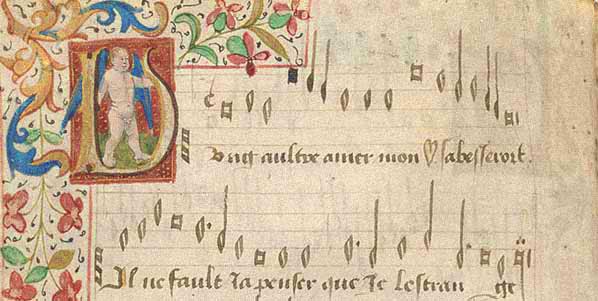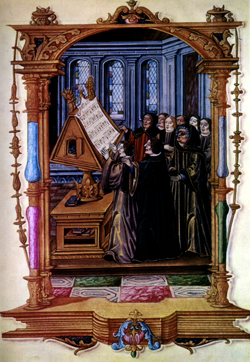

|
Like Dufay before him and Josquin after him, Johannes Ockeghem (circa 1410 - 1497) was a native of the Low Countries and a representative of the Franco-Flemish school of music. Unlike Dufay and Josquin, Ockeghem was not a part of the Pope's special choir, the schola cantorum. Rather Ockeghem remained within modern day Belgium and France and, as the number of laments composed in his honor attests, at the time of his death was considered the greatest composer of his generation. The accolades stem not only from his skilled, complex and elegant compositions, both sacred and secular, but also through his lionization in the writings of the influential theorist Joannes Tinctoris (c. 1435-1511). In the dedication to his 1476 volume Proportionale Musicale Tinctoris wrote: At this time, consequently, the possibilities of our music have been so marvelously increased that there appears to be a new art, if I may so call it, whose fount and origin is held to be among the English, of whom Dunstable stood forth as chief. Contemporary with him in France were Dufay and Binchoys, to whom directly succeeded the moderns Ockeghem, Busnoys, Regis and Caron, who are the most excellent of all the composers I ever heard. Nor can the English, who are popularly said to shout while the French sing, stand comparison with them. For the French contrive music in the newest manner for the new times, while the English continue to use one and the same style of composition, which shows a wretched poverty of invention. As a person, he was similarly lauded. Francesco Florio described him in 1477 as: "so handsome in appearance, so grave and gracious in manner and speech." To this date, talent and a good publicist is key to having a successful career as a composer. In the Catholic Mass the Agnus Dei accompanies the fraction or the breaking of the consecrated wafer which has through the ritual of the Eucharist been changed into the literal body of Christ. Typically this is a moment of reflection and great solemnity. In cyclic masses, it often is the final section and thus was treated with especial reverence by composers. Ockeghem's setting is no different in this regard. While Ockeghem is known as a master of complex counterpoint - he wrote a Mass in which all the parts are in a constant prolation canon (a canon in which each part is at a different speed: as if each part were to sing "The Star Spangled Banner" at a different tempo and the result would follow the norms of counterpoint), this setting is, frankly, quite simple. Consequently, some scholars assume it is among the earliest L'Homme Arme masses - the reasoning goes that had Ockeghem known Dufay's mass he would have sought to one-up him. Such gamesmanship was common among the composers of this period. The Cantus Firmus here is found in the bass voice: in our recording the bass sings the words of L'Homme Arme, rather than Agnus Dei; in the original maanuscript it is written thus. While building a piece from the bassline might seem normal to us, accustomed as we are to the bass guiding the harmony, this was actually a radical idea at the time: cantus firmi were generally placed in the second-lowest voice, the tenor. In listening try to note where cadences fall and how Ockeghem uses different combinations of voices within the piece to give it a sense of forward momentum. |
 Singers clustered around a partbook Ockeghem is said to be the old man at the right. |
| Agnus Dei | 0:00 | Agnus I: 3-voice opening |
| Dei qui tollis peccata mundi | 0:15 | Agnus I (continued): Entrance of L'Homme Arme tune in Bass. Returns to three voice texture of before. |
| Miserere No- | 0:42 | Agnus I (continued): Entrance of second part of first line of "L'homme arme." Choir then continues in free counterpoint. |
| -bis | 1:08 | Agnus I (continued): Final cadence of Agnus I. |
| Agnus Dei | 1:20 | Agnus II: 2-voice freely composed; no cantus firmus. Soprano and Tenor solo. |
| qui tollis peccata mundi | 1:40 | Agnus II (continued): Bass and Tenor solo. |
| miserere nobis | 2:10 | Agnus II (continued): Soprano, Tenor and Bass |
| Agnus Dei | 2:35 | Agnus III: Tenor with Bass in duet. Bass has cantus firmus. |
| Qui tollis peccata mundi | 3:00 | Agnus III (continued): Tenor and soprano solo. No cantus firmus. |
| Qui tollis peccata mundi | 3:00 | Agnus III (continued): Bass solo with another Bass singing part of L'Homme Arme. |
| Qui tollis peccata mundi | 3:39 | Agnus III (continued): Other voices enter over fragments of L'Homme Arme. |
| Dona nobis pacem | 4:03 | Agnus III (continued): All four voices. Cantus firmus in low bass. |
Translation
|